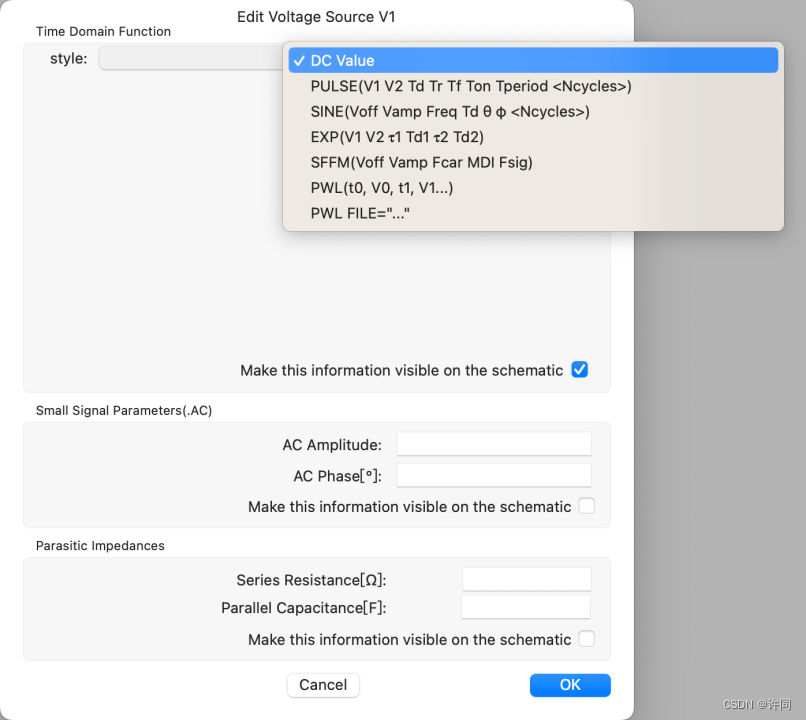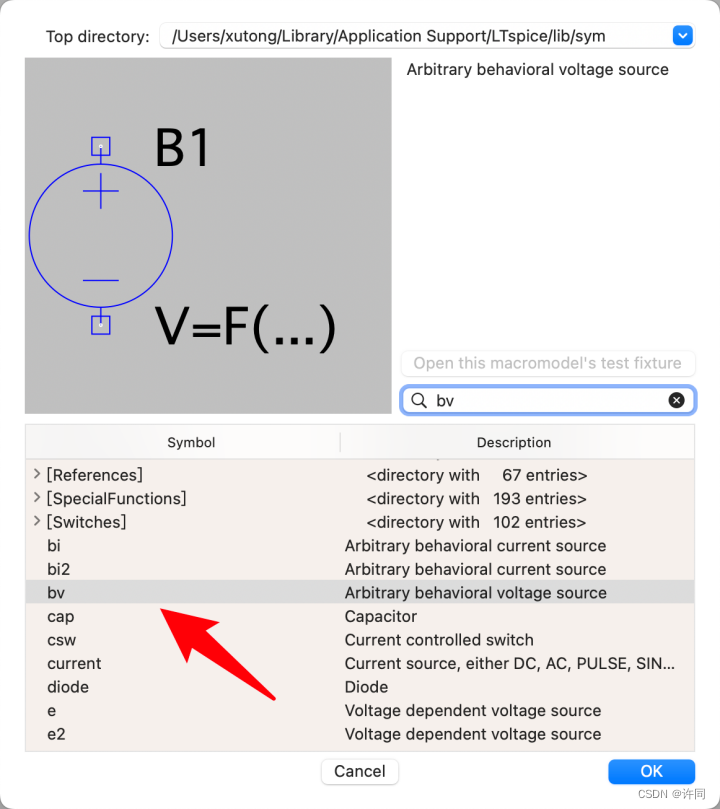LTspice(11) arbitrary behavioral source
在电子系统里我们需要的信号多种多样,所以为了更加准确的仿真,输入信号应该也是多种多样。在LTspice里通常的电压源支持的模式虽然比较多,但是还不够全面。
常规的电压源可选配置如下⬇️

图1:常规电压源可选配置
如果你的信号超出了这个的定义范围,那么就需要使用arbitrary voltage,在SPICE里面他的开头是B可以是BV也可以是BI分别代表随机电压和电流。以下给出了帮助里的说明。
| B. Arbitrary Behavioral Voltage or Current Sources Symbol names: BV, BI Syntax: Bnnn n001 n002 V=<expression> [ic=<value>] Bnnn n001 n002 I=<expression> [ic=<value>] The first syntax specifies a behavioral voltage source and the next is a behavioral current source. For the current source, a parallel resistance may be specified with the Rpar instance parameter. |
在任意行为仿真源(arbitrary behavioral source)中 time代表当前仿真时间pi代表
3.14159265358979323846.可以使用LTspice几乎所有的表达式,支持的表达式如下所示。
| Function Name | Description |
| abs(x) | Absolute value of x |
| absdelay(x,t[,tmax]) | x delayed by t. Optional max delay notification tmax. |
| acos(x) | Real part of the arc cosine of x, e.g., acos(-5) returns 3.14159, not 3.14159+2.29243i |
| arccos(x) | Synonym for acos() |
| acosh(x) | Real part of the arc hyperbolic cosine of x, e.g., acosh(.5) returns 0, not 1.0472i |
| asin(x) | Real part of the arc sine of x, asin(-5) is -1.57080, not -1.57080+2.29243i |
| arcsin(x) | Synonym for asin() |
| asinh(x) | Arc hyperbolic sine |
| atan(x) | Arc tangent of x |
| arctan(x) | Synonym for atan() |
| atan2(y,x) | Four quadrant arc tangent of y/x |
| atanh(x) | Arc hyperbolic tangent |
| buf(x) | 1 if x > .5, else 0 |
| ceil(x) | Integer equal or greater than x |
| cos(x) | Cosine of x |
| cosh(x) | Hyperbolic cosine of x |
| ddt(x) | Time derivative of x |
| delay(x,t[,tmax] | Same as absdelay() |
| dnlim(x,y,z) | Similar to max(x,y) but with a continuous 1st derivative transition width z |
| exp(x) | e to the x |
| floor(x) | Integer equal to or less than x |
| hypot(x,y) | sqrt(x**2 + y**2) |
| idt(x[,ic[,a]]) | Integrate x, optional initial condition ic, reset if a is true. |
| idtmod(x[,ic[,m[,o]]] | Integrate x, optional initial condition ic, reset on reaching modulus m, offset output by o. |
| if(x,y,z) | If x > .5, then y else z |
| int(x) | Convert x to integer |
| inv(x) | 0. if x > .5, else 1. |
| limit(x,y,z) | Intermediate value of x, y, and z |
| ln(x) | Natural logarithm of x |
| log(x) | Alternate syntax for ln() |
| log10(x) | Base 10 logarithm |
| max(x,y) | The greater of x or y |
| min(x,y) | The smaller of x or y |
| pow(x,y) | Real part of x**y, e.g., pow(-1,.5)=0, not i. |
| pwr(x,y) | abs(x)**y |
| pwrs(x,y) | sgn(x)*abs(x)**y |
| Random number between 0 and 1 depending on the integer value of x. | |
| random(x) | Similar to rand(), but smoothly transitions between values. |
| round(x) | Nearest integer to x |
| sdt(x[,ic[,assert]]) | Alternate syntax for idt() |
| sgn(x) | Sign of x |
| sin(x) | Sine of x |
| sinh(x) | Hyperbolic sine of x |
| smallsig() | Returns 1 if a .ac or .noise analysis is being done. Otherwise 0. |
| sqrt(x) | Square root of x |
| table(x,a,b,c,d,...) | Interpolate a value for x based on a look up table given as a set of pairs of points. |
| tan(x) | Tangent of x. |
| tanh(x) | Hyperbolic tangent of x |
| u(x) | Unit step, i.e., 1 if x > 0., else 0. |
| uplim(x,y,z) | Similar to min(x,y) but with a continuous 1st derivative transition width z |
| uramp(x) | x if x > 0., else 0. |
| white(x) | Random number between -.5 and .5 smoothly transitions between values even more smoothly than random(). |
| !(x) | Alternative syntax for inv(x) |
| ~(x) | Alternative syntax for inv(x) |
• The following operations, grouped in reverse order of precedence of evaluation:
| Operand | Description |
| & | Convert the expressions to either side to Boolean, then AND. |
| | | Convert the expressions to either side to Boolean, then OR. |
| ^ | Convert the expressions to either side to Boolean, then XOR. |
| > | True if expression on the left is greater than the expression on the right, otherwise false. |
| < | True if expression on the left is less than the expression on the right, otherwise false. |
| >= | True if expression on the left is greater than or equal the expression on the right, otherwise false. |
| <= | True if expression on the left is less than or equal the expression on the right, otherwise false. |
| + | Floating point addition |
| - | Floating point subtraction |
| * | Floating point multiplication |
| / | Floating point division |
| ** | Raise left hand side to power of right hand side. Only the real part is returned, e.g., -1**1.5 gives zero not i. |
| ! | Convert the following expression to Boolean and invert. |
了解了大概咋回事,咱们就开始搭建一个简单的任意电压源(arbitrary behavioral voltage source)吧!
在LTspice的器件库中直接搜索bv即可,如图2所示。

图2:任意行为电压源
放置好以后我们就可以对其进行测试,我们可以弄个以时间变化的电压值。如图3所示,仿真结果如图4所示。

图3:随时间变化的电压

图4:仿真结果
也许我们想来个随机信号,那我们只要将随机信号的公式带入即可。我们使用random(x)函数,对于它的描述如下所示。
| rand(x) | Random number between 0 and 1 depending on the integer value of x. |
| random(x) | Similar to rand(), but smoothly transitions between values. |
他可以生成0~1之间的数,具体取决于x的整数值。设置如图5所示。仿真结果如图6所示。

图5:随机电压设置

图6:仿真结果

图7:PP值

图8:Meas测量结果 测量代码:.MEAS TRAN B1 PP V(vout)
电路测试代码:
| * xutong 2023/3/14 B1 vout 0 V=random(time*1000)/1000 .tran 10 .MEAS TRAN B1 PP V(vout) .backanno .end |
今天就先聊到这里啦,拜拜~
更多精彩内容关注公众号 xuyutong






















 8686
8686











 被折叠的 条评论
为什么被折叠?
被折叠的 条评论
为什么被折叠?








